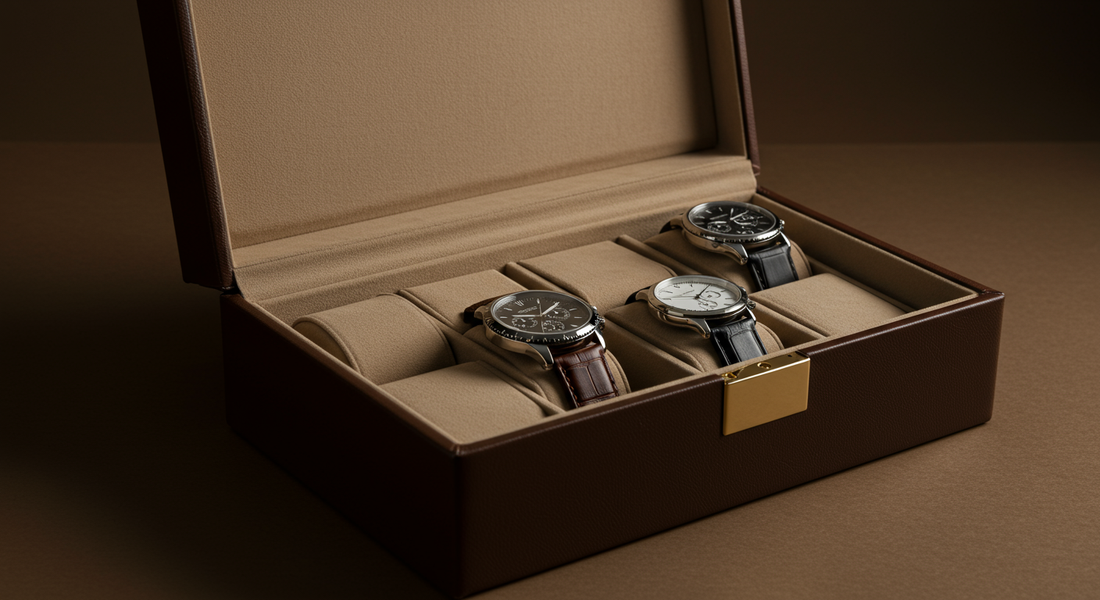You wouldn’t park a vintage Ferrari outside in the rain, so why treat your luxury watch any differently? Watch box storage isn't just about organization—it’s essential to maintaining the value, function, and aesthetic of your timepieces. Whether you’ve got one prized Rolex or a growing fleet of vintage Omegas, how you store your watches speaks volumes about how well they’ll age. At WatchWorks, we’ve seen firsthand how proper storage can extend the life of luxury watches and preserve their resale value.
TLDR – Quick Guide
-
A good watch box protects against dust, scratches, and moisture.
-
Storage matters more as your collection grows.
-
Choose a box that fits your lifestyle—display or vault.
-
Travel often? Invest in a secure, padded watch roll.
-
Don’t forget about humidity and light exposure.
Implementation Tactics: Watch Storage Done Right
1. Why Storage Even Matters
Watches are small machines—and like any machine, they can break down without proper care. Storing your watch in a safe, padded box protects it from:
-
Dust buildup that clogs movement
-
Scratches from metal-on-metal contact
-
Moisture that can rust even stainless steel over time
2. Choose the Right Watch Box
Not all watch boxes are created equal. Look for:
-
Individual compartments with soft lining (velvet, suede, or leather)
-
Padded cushions that hold the watch snugly
-
A glass top if you like to display your collection
-
A lockable box if you’re security-minded
3. Watch Rolls for Travel
If you're frequently on the go, a quality leather or canvas watch roll is essential. It keeps your watch from bouncing around in your luggage and protects it from hard impacts.
4. Humidity and Light: Silent Killers
Even indoors, your watches face threats:
-
Avoid direct sunlight, which can fade dials and damage luminous paint
-
Keep away from humid environments (yes, that includes your bathroom drawer)
-
Use silica gel packs or a mini dehumidifier in your storage space
5. Rotate Your Watches
Letting mechanical watches sit unused for long stretches isn’t ideal. If you have automatics, consider a watch winder—or at least wind them manually every few weeks.
6. Clean Before Storing
Wipe down your watch with a soft microfiber cloth before storage. Residual sweat or skin oils can wear down the strap or metal if left for weeks.
Key Takeaways
-
Proper watch box storage maintains value and prevents damage.
-
Boxes should offer padding, separation, and moisture resistance.
-
Use silica gel packs or a dehumidifier if you’re in a humid climate.
-
Display boxes are great for daily rotation; locked boxes are best for safekeeping.
-
Travel? Get a dedicated watch roll to protect your piece on the go.
FAQs
1. Can I store my watch in the box it came in?
Yes, especially if it has a padded interior. But dedicated watch boxes typically offer better compartmentalization and protection.
2. Should I use a watch winder?
Only for automatic watches and only if you rotate them often. Otherwise, manual winding every few weeks will do.
3. Is it safe to store watches in a safe deposit box?
Yes, but make sure it’s climate-controlled. Otherwise, you risk moisture buildup or degradation over time.
4. How many watches should one box hold?
Depends on your collection. For starters, a 3–6 slot box works well. Serious collectors may want a 10+ slot or a modular storage system.
5. Are watch rolls worth it for daily commuters?
Definitely. If you're changing watches at work or traveling often, a padded roll protects your piece in transit.
